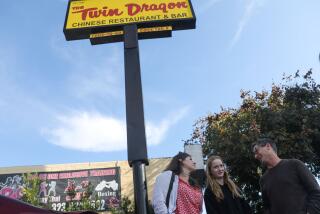Cash Register Ringing in German Hamlet
- Share via
SEIFFEN, Germany — The ghost of Christmas past is boosting fortunes in this village in former East Germany. Known for high-quality wooden Christmas ornaments, toys and decorations, Seiffen has enjoyed a revival in the decade since German unification by doggedly preserving traditions.
Wooden workshops, stores and inns line the main street along the bottom of a valley surrounded by hills in the Erzgebirge region near the Czech border. Carved wooden ornaments bulge from nearly every window and signs touting “tax-free shopping” and the acceptance of various credit cards openly embrace modern commerce in this town of 3,000.
Busloads of mostly elderly tourists wander the streets, eager to acquire hand-carved, wooden Christmas objects such as colorful nutcrackers and whimsical “smoking men” with pipes in hand, made much as they were a century ago.
Another favorite is the multilevel Christmas pyramid with scenes such as angels blowing horns, a shepherd scene and the adoration of baby Jesus crowned by a propeller-like top.
Though local toy production dates back to 1750, booming tourism and trade have revived only in recent years after the collapse of East Germany. The end of the Soviet-allied government meant families could reacquire the old businesses East Berlin had nationalized over many years.
“In 1972, the state came to my father and said we are offering you the following price for your company, and he had to sign,” said Matthias Schalling, 37, co-owner of Schalling Volkskunst. “It was a struggle to get back the business, but after many months we were able to begin anew.”
Christian Ulbricht, who moved his nutcracker business to West Germany after World War II, bought back the old shop in 1992, and his daughter Ines, who grew up in Bavaria, came in to manage its now 90 workers.
“At first, the people were very reserved with us as we came from the west; this is a tiny village,” she said. “In Seiffen, they don’t want to let in outsiders. Now things are going well. We now have revenue of 8 million marks [$3.6 million]. Five years ago it was perhaps 4 million.”
*
For some small craftsmen, the end of communism meant adjusting to and then benefiting from market realities.
Volker Flath, owner of Guenther Flath & Son, was allowed to keep his business even in East Germany as the government permitted the smallest workshops to remain private--if they played by central planning rules.
“The plan was given in January and we knew what we had to deliver by December,” Flath said. “If you did not fulfill the plan, you would have some explaining to do.”
Eager to earn hard currency, the government sold many of the best Seiffen toys and decorations abroad.
For Flath, that meant earning the local equivalent of about 21 West German marks ($9.30) for his Christmas pyramid. East Germany’s foreign trade body would then sell it for 58 marks, and stores in West Germany would retail it for 380 marks.
Yet in an economy of perpetual shortage, small workshops had to scramble to keep the wooden figures coming.
“If our problem today is marketing our products, back then it was just getting basic materials and machines,” Schalling said.
Visitors combing the streets for Seiffen products then could not find much because only the town museum offered items for sale, a paltry selection at that. It was forbidden to sell directly to the public but some under-the-table trade did take place.
“One could trade say a pyramid for some car spare parts,” Flath said.
Today, many of Seiffen’s workshops cut out the middlemen and sell directly to the public in 40 “factory outlet” shops across town. The number of tourists--about a million a year--has doubled in the last five years or so, Acting Mayor Heinz Wagener said. As a result, few villagers are unemployed in a region where as many as 20% are without work.
Slowly, even as they continue to make things by hand, the workshops are expanding into the Internet. Christian Ulbricht keeps American collectors up to date with Web pages in English and directs them to a growing chain of U.S. retailers.
Tour companies on the Internet also offer Christmas wonderland tours that include Seiffen.
The town offers a strong lure for the nostalgia market, but, somewhat oddly, few children come. “This is a problem,” Wagener said. “In the future, the guests will be different. Now most are more than 50 years old. We are working on a new tourist concept to make it more attractive to young families.”
One long-term potential threat to Seiffen could come from the Czech Republic, less than two miles away, which has capable workers and far lower labor costs.
“In the next decade, this difficulty will grow as product costs rise and we will be confronted with where we should produce,” Schalling said.
*
Rumors abound that some local firms subcontract across the border, but publicly everyone takes a “Seiffen first” line.
“We feel an obligation to feel concerned about local workers,” Ulbricht said. “It would be bad if someone offers jobs abroad. We have so much unemployment in the region.”
Even if tempted, some fear a backlash could result from hiring Czech workers or opening a workshop across the border.
“My workers earn 12 to 15 marks an hour,” said Gisbert Neuber, who specializes in tiny wooden scenes such as a woman tending her ducks crammed into a matchbox.
“In the Czech Republic, they would work for 3 to 4 marks, but I just don’t want to take the risk.”
For now, Seiffen’s formula of old-style wooden wonders made as they were so many holiday seasons ago seems to perfectly embody a traditional Christmas spirit.
More to Read
Sign up for Essential California
The most important California stories and recommendations in your inbox every morning.
You may occasionally receive promotional content from the Los Angeles Times.













